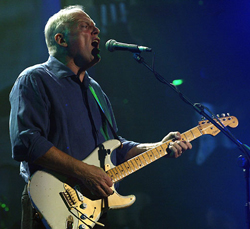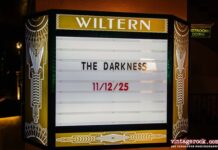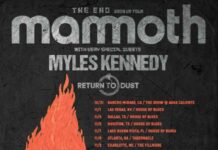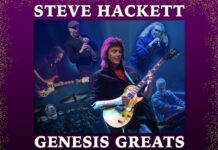Concert Review by Shawn Perry
David Gilmour is, in so many ways, a hard nut to crack. Back in the mid 80s, he went to war with Roger Waters in a power struggle over the name and dollar value of Pink Floyd. Waters, a founding member and the group’s bassist, chief lyricist, and de facto leader during their 70s heyday, wanted to put the sleeping giant to bed. But Gilmour wasn’t done being the guitarist and sweeter voice of what was — and remains — a massive money-making machine. He figured by attaching himself, drummer Nick Mason, and eventually keyboardist Richard Wright to any particular musical partnership without the bassist on board could still be called Pink Floyd. To Waters’ extreme annoyance, the three released A Momentary Lapse Of Reason and mounted a colossal world tour in its wake. Waters resoundly fired back with Radio Kaos, a noble experiment in contemporary conceptual hodgepodge that narrowly missed its mark. Two years later, Waters staged his own version The Wall with himself in the lead role backed by a wacky cast to lift the story from its dreary doldrums. Meanwhile, the sleeping giant went into temporary hibernation.
In 1994, the two camps were at it again. The Waterless Floyd released The Division Bell, with lyrics primarily penned by Gilmour’s wife Polly Samson. They followed up with a record-breaking stadium tour, performingThe Dark Side Of The Moon in its entirety at a few choice stops along the way. Waters rose to the challenge and released the brilliant Amused To Death. Without a tour to support it, the record didn’t get the attention it deserved and was largely ignored. It would be another six years until Waters hit the road and paid proper homage to the record. During the same tour, he played a batch of Pink Floyd nuggets that hadn’t seen the light of day in over 20 years, not even by the Waterless version. Check mate!
After The Division Bell and its ensuing fallout, the Gilmour-led Pink Floyd went quietly into the night. In 1996, Rick Wright made Broken China, a nice little solo album, while Gilmour and Mason stayed home and counted their millions. It wasn’t until 2002 that Gilmour resurfaced — this time at a low-key charity concert for his friend Robert Wyatt. His performance came out on DVD, showing the world that David Gilmour — heavier, grayer and thoroughly domesticated — still had his chops. But he wasn’t motivated enough to reawaken the sleeping giant for another whirlwind voyage. The truth of the matter was that the guitarist had more or less retired, and as far as he was concerned, Pink Floyd had no plans of reconvening anytime soon. Then one summer day in 2005, Gilmour received a phone call from Roger Waters.
It turns out Waters, of all people, had mellowed to the idea of Pink Floyd. He was, remarkably, the least weathered of the four principal members (make that five if you count the madcap Syd Barrett) and, in his view, the timing was right to put the band back together for the good cause of Live 8. How could Gilmour refuse? The two one-time adversaries signed up, Mason and Wright fell in, and the four played a stellar set that clocked in at under a half-hour. Offers of $250 million came in for a full-blown tour, but Gilmour, a staunch philanthropist, was the first to step up and say he wasn’t interested. In fact, in a twist stranger than science fiction, it was Waters who turned the tables by expressing an ambiguous desire to accept the offer. Gilmour inadvertently upped the ante by donating his proceeds from the accelerated sales of Floyd’s golden catalog due to the Live 8 reunion. But that wasn’t the only card he had up his sleeve.
In the last year, various factions tied to the Pink Floyd organization have come out from behind the wall. Mason, the only member to have played on all of Pink Floyd’s records, wrote Inside Out, a sensational coffee table book about the group. Not to be outdone, Waters released his long-awaited opera Ca Ira and spoke publicly about plans to roll out The Wall on Broadway. Gilmour trumped the lot by recruiting Wright, Graham Nash, David Crosby, and Phil Manzanera to record a solo album, On An Island. And then the man who had remarked years earlier that the road was a young man’s game launched a short tour of Europe and America. Although the shows were small in scale, the content was a virtual history lesson on why David Gilmour continues, to this day, to be so highly revered as a musician.
Gilmour’s April 20th concert at the Gibson Amphitheater was his final stop of the North American tour and, if you do the math, perhaps the last time the guitarist will ever perform on these shores again. Of course, like most rock icons, he could change his mind and return for another round. Musicians are a fickle bunch, so one should never take them at their word. But something about the tone of the Gilmour tour indicated a mood of definiteness and finality. At the end of the night, I couldn’t see how he could possibly top what I had just witnessed.
When I arrived at the venue, I couldn’t help but notice the abundance of Pink Floyd T-shirts worn by graying and/or balding guys with massive beer bellies. I also saw plenty of youngsters wearing Floyd shirts, which confirms the band’s lasting, universal appeal. Young and old, fat and skinny — it doesn’t seem to matter what your station in life is when it comes to Pink Floyd. And let’s face it: this was a Pink Floyd event more than a David Gilmour concert. The guitarist was only too aware of the difficulties associated with escaping the shadow of the sleeping giant. On this tour, with Rick Wright on stage, Gilmour was only too happy to indulge his audience with what they wanted coupled with what they would never have expected.
My seat was in the upper echelons of the amphitheater, but I had a fairly good view. In fact, I felt bad for the people below me because they had needlessly squandered away hundreds of dollars on seats that were no better than mine. For the most part, I have to maintain a sense of well-being to placate my dissatisfaction with the nosebleeds. But my seat was in working order and free from other encumbrances like drunken fools who insist on standing throughout the performance whist trying to clap in time with “Shine On You Crazy Diamond,” a song that doesn’t ask for a clap along. I spotted a few of those in and around the orchestra pit.
The balcony, in addition to its distance from the stage, offered one other outstanding disadvantage: it was as stuffy as a wigwam in the Sahara. Many people were using the On An Island placards draped over each seat as makeshift fans. As the evening opened up, it became obvious that on 4/20 and the crowd in a rather Floydian headspace, the general atmosphere was blooming with an intoxicating aroma meshed over the breezy music. That didn’t make it any cooler, but it certainly contributed to the mood.
As promised, the show started promptly at 8:15, which sent the late-arriving throngs into a semi-panic mode, resulting in a choppy viewing of the opening “Breathe/Time/Breathe (Reprise)” medley. Previous shows had the Dark Side segment appearing in the second part of the program, but along the way Gilmour and his band (Wright on keyboards, Manzanera on guitar, Dick Parry on saxophone, Jon Carin on keyboards, Guy Pratt on bass, and Steve DiStanislao on drums) must have felt the need to mix things up. It served as an excellent set-up for On An Island, which was played in its entirety.

David Crosby and Graham Nash, who had previously joined Gilmour on stage in New York and at the Kodak Theater in Hollywood the night before, walked out to reprise their background vocals on the title track. They returned later in the program to pipe in on “Shine On You Crazy Diamond” and performed an a capella version of “Find The Cost Of Freedom,” an old CSNY song, with Gilmour.
Many of the songs from On An Island had Gilmour switch-hitting instrumentally. One minute he was playing a Stratocaster, the next a Les Paul. Then he strapped on an acoustic, walked over to his pedal steel, and brushed out a few angelic licks. During “Red Sky At Night,” he blew out some ghostly noise on the saxophone, then he played a toy store banjo for the intro of “When I Close My Eyes.” Of course, nothing compares to the ethereal guitar tone he’s famous for, no matter which axe he’s wielding. In between numbers, various catcalls from the audience formed such simpleminded phrases as “David Gilmour.” To which, the guitarist in a dry, British dead-pan manner replied: “Yeah, I know my name…” And then it dawned on me: the name and the tone are almost interchangeable. Almost.
When the classic material was trotted out during the second set, it was like climbing aboard a Pink Floyd thrill ride flush with nostalgia and surprises. In my infinite wisdom, I had been listening to other shows from the tour and had a good idea of what to expect, songwise. But then they whipped out the first Pink Floyd single released before Gilmour was even in the band, the old Syd Barrett chestnut “Arnold Layne” featuring none other than Rick Wright on vocals. I was transported back to 1967 as Wright punched out a solo on his Farfisa.
From there, Gilmour flashed forward to 1994 with “Coming Back To Life” and “High Hopes,” both from The Division Bell. Many of the people I had talked to before the show were much more receptive to this “newer” (as if 12 years old is newer) Floyd material than albums before Dark Side Of The Moon. All of which made “Wot…Uh The Deal,” “Fat Old Sun” and “Echoes” — all pre-Dark Side — personal highlights for me. These were the numbers Gilmour hadn’t played on stage, if ever, with Pink Floyd in almost 30 years.
The encore of “Wish You Were Here” and “Comfortably Numb,” which sandwiched the aforementioned performance of “Find The Cost Of Freedom,” brought the audience to their feet, fists raised, singing along at the top of their lungs, Bic lighters and cell phones hoisted skyward in a united formation of benevolence and satisfaction.
Indeed, this show was much more representative of Pink Floyd’s songbook than the A Momentary Lapse Of Reason and The Division Bell tours, both of which focused primarily on material from Dark Side Of the Moon onward. Still, when I first saw the set list for this tour, I was a bit distressed that Gilmour was forgoing any of the songs from his previous two solo albums. Adding “There’s No Way Out Of Here,” “Murder” or “All Lovers Are Deranged” would have definitely shown there’s more to the guitarist than his current solo album and Pink Floyd. Why we’re not getting the full picture of this multifaceted musician is a complete mystery. Like I said, he’s one hard nut to crack.
Once the tour concludes with two shows at London’s Royal Albert Hall, Roger Waters is set to play dates in Europe and America, rolling out The Dark Side Of The Moon in its entirety at each and every show. At select venues, Nick Mason will reportedly sit in, all of which makes perfect sense: Gilmour has Wright so why shouldn’t Waters have Mason. It’s like you’re getting the two halves of Pink Floyd in small, digestible portions.
This morning, I’ve purchased tickets for Waters’ appearance at the Hollywood Bowl, the very location where Pink Floyd played The Dark Side Of The Moon, unreleased at the time, 34 years earlier. I bought the tickets in part to check in on the general call-and-response routine taking place amongst the members of Pink Floyd. At $100 a pop, I’m hoping Waters’ performances, which can be vocally challenging at times, will be on par with Gilmour’s. Either way, I knew I’d regret it if I passed. After all, it’s becoming glaringly apparent that 2006 is shaping up to be a great year for Pink Floyd fans. And perhaps a precursor to bigger and bolder things to come.




















